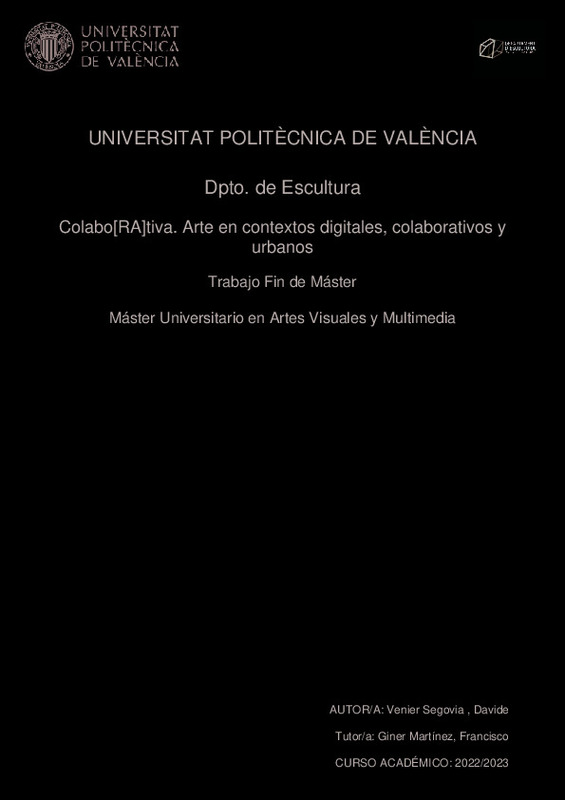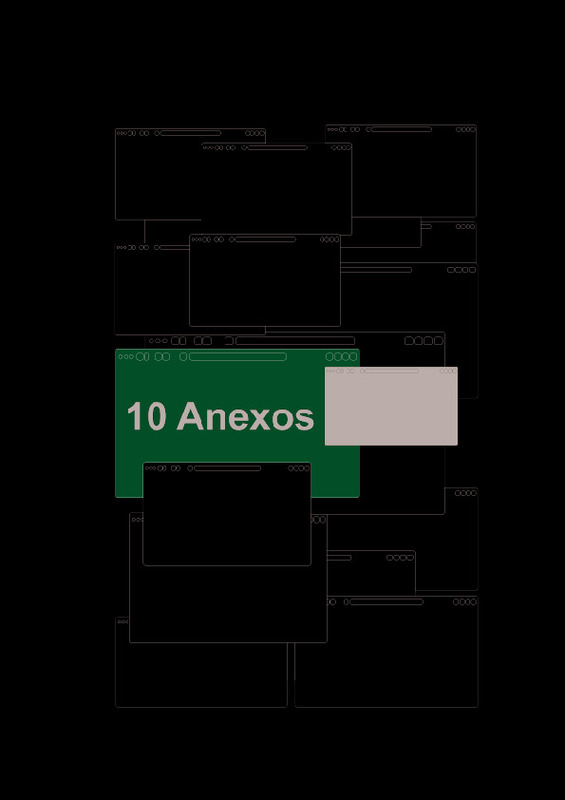JavaScript is disabled for your browser. Some features of this site may not work without it.
Buscar en RiuNet
Listar
Mi cuenta
Estadísticas
Ayuda RiuNet
Admin. UPV
Colabo[RA]tiva. Arte en contextos digitales, colaborativos y urbanos
Mostrar el registro sencillo del ítem
Ficheros en el ítem
| dc.contributor.advisor | Giner Martínez, Francisco
|
es_ES |
| dc.contributor.author | Venier Segovia, Davide
|
es_ES |
| dc.date.accessioned | 2023-04-21T11:39:59Z | |
| dc.date.available | 2023-04-21T11:39:59Z | |
| dc.date.created | 2023-03-31 | |
| dc.date.issued | 2023-04-21 | es_ES |
| dc.identifier.uri | http://hdl.handle.net/10251/192901 | |
| dc.description.abstract | [ES] Este trabajo de fin de máster titulado: "Colabo[RA]tiva - Arte en contextos digitales, colaborativos y urbanos", propone una investigación teórica práctica que combina estudios sobre el arte generativo colaborativo y el desarrollo, a priori, de una aplicación para dispositivos móviles. Este desarrollo en concreto es el punto de partida para generar nueva arte. De hecho, el proyecto consiste en una aplicación que ofrece la posibilidad de crear en realidad aumentada su propio espacio de arte urbano o, más simplemente, admirar las representaciones de arte urbano ya existentes. También se decidió tener en cuenta las áreas: Campus de Vera - UPV, donde se realizarán las pruebas de funcionamiento aprovechando la comunidad universitaria y, sobre todo, el barrio de Cabañal, lugar de verdadero fin y objetivo de la aplicación que tiene la intención de rehabilitar de forma artística este barrio histórico. Posteriormente durante el uso de la aplicación, el usuario consciente y de manera personal enviará datos, de diferente naturaleza, a una base de datos que tendrá la tarea de almacenar todas estas entradas y, a su vez, enviarlas a una página web. En este último paso se producirá el cambio de estos últimos de lineales y comprensibles a visuales y abstractos. De hecho, en este preciso momento, los inputs se convertirán en una representación visual, pero sobre todo en una representación única. Esto se debe a que cada dato transmitido será recogido y enviado de forma directa e instantánea. De esta manera y a través de información específica se creará una verdadera obra de arte generativa que surge del uso exclusivo de la instalación. Hecha esta premisa, la tesis tendrá una primera parte más teórica y centrada en el estudio y la expansión de la realidad aumentada y del arte generativo. En este primer paso, se introducirán conceptos teóricos que han influido y ayudado al estudiante a concretar el concepto base de este trabajo de fin de master. Luego, en la segunda parte se describirá el proceso completo que llevó a la finalización de la aplicación. Esta última, estará compuesta por scripts de programación y representaciones del diseño de la aplicación, además, esta etapa determinará cada paso y dificultad que se encontraron durante el desarrollo del prototipo. Por último, se describirá la parte de prueba de la aplicación por un pequeño grupo de personas, de diferentes edades, que tendrán como objetivo interactuar con la aplicación y encontrar cualquier problema relacionado con cualquier mal funcionamiento. Esta última parte representa el primer enfoque entre el usuario y la instalación, y además de garantizar su funcionamiento, hará entender si Colabo[RA]tiva es realmente un producto interesante y estimulante para el público. Todas estas partes y pasos se convierten en fundamentos para hacer comprender el proyecto en sí, su objetivo y sus perspectivas futuras. Pero no hay que olvidar que Colabo[RA]tiva no nace solamente como una aplicación profesional y acabada, si no que lleva consigo un fuerte componente artístico y experimental. En algunas ocasiones, también, descontextualizando y criticando conceptos de diferente naturaleza. | es_ES |
| dc.description.abstract | [EN] This final work of master entitled: "Colabo[RA]tiva - Art in digital, collaborative and urban contexts", proposes a theoretical and practical research that combines studies on collaborative generative art and development, a priori, from an application for mobile devices. This development is the starting point for generating new art. In fact, the project consists of an application that offers the possibility to create in augmented reality your own urban art space or, more simply, admire the existing urban art representations. It was also decided to consider the areas: Vera Campus - UPV, where the operational tests will take advantage of the university community and, above all the neighbourhood of Cabanyal, Place of true purpose and purpose of the application that intends to artistically rehabilitate this historic neighbourhood. Later during the use of the application, the user consciously and personally will send data, of different nature, to a database that will have the task of storing all these entries and, in turn, sending them to a website. In this last step, the latter will change from linear and understandable to visual and abstract. In fact, at this very moment, input will become a visual representation, but a unique representation. This is because each data transmitted will be collected and sent directly and instantaneously. In this way and through specific information will be created a true work of generative art that arises from the exclusive use of the installation. Given this premise, the thesis will have a more theoretical first part focused on the study and expansion of augmented reality and generative art. In this first step, theoretical concepts will be introduced that have influenced and helped the student to concretize the basic concept of this master¿s thesis. Then the second part will describe the complete process that led to the completion of the application. The latter will be composed of programming scripts and representations of the design of the application, in addition, this stage will determine each step and difficulty encountered during the development of the prototype. Finally, the test part of the application will be described by a small group of people, of different ages, who will aim to interact with the application and find any problems related to any malfunction. This last part represents the first approach between the user and the installation, and in addition to ensuring its operation, it will make understand if Colabo[RA]tiva is really an interesting and stimulating product for the public. All these parts and steps become foundations for understanding the project itself, its objective and its prospects. But we must not forget that Colabo[RA]tiva is not only born as a professional and finished application, but it also has a strong artistic and experimental component. Sometimes, too, decontextualizing and criticizing concepts of different nature | es_ES |
| dc.format.extent | 95 | es_ES |
| dc.language | Español | es_ES |
| dc.publisher | Universitat Politècnica de València | es_ES |
| dc.rights | Reconocimiento (by) | es_ES |
| dc.subject | Arte generativo | es_ES |
| dc.subject | Aplicación móvil | es_ES |
| dc.subject | Dispositivos móviles | es_ES |
| dc.subject | Realidad aumentada | es_ES |
| dc.subject | Arte callejero | es_ES |
| dc.subject | Application | es_ES |
| dc.subject | Mobile devices | es_ES |
| dc.subject | Augmented reality | es_ES |
| dc.subject | Street art | es_ES |
| dc.subject | Generative art | es_ES |
| dc.subject | Mobile application | es_ES |
| dc.subject.classification | PINTURA | es_ES |
| dc.subject.other | Máster Universitario en Artes Visuales y Multimedia-Màster Universitari en Arts Visuals i Multimèdia | es_ES |
| dc.title | Colabo[RA]tiva. Arte en contextos digitales, colaborativos y urbanos | es_ES |
| dc.title.alternative | Colabo[RA]tiva. Art in digital, collaborative and urban contexts. | es_ES |
| dc.title.alternative | Colabo[RA]tiva. Art en contextos digitals, col·laboratius i urbans | es_ES |
| dc.type | Tesis de máster | es_ES |
| dc.rights.accessRights | Abierto | es_ES |
| dc.contributor.affiliation | Universitat Politècnica de València. Departamento de Pintura - Departament de Pintura | es_ES |
| dc.description.bibliographicCitation | Venier Segovia, D. (2023). Colabo[RA]tiva. Arte en contextos digitales, colaborativos y urbanos. Universitat Politècnica de València. http://hdl.handle.net/10251/192901 | es_ES |
| dc.description.accrualMethod | TFGM | es_ES |
| dc.relation.pasarela | TFGM\154762 | es_ES |







